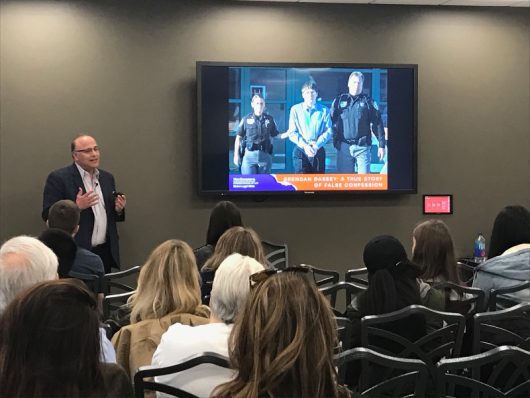
Steven Drizin, post conviction lawyer for Brendan Dassey, speaks at The Ohio Union for the Ohio State chapter of the Ohio Innocence Project. Credit: Alexandra Hulvalchick | Lantern reporter
On Wednesday, the Ohio State chapter of the Ohio Innocence Project — the student organization OIPu at OSU — hosted Steven Drizin, the post-conviction attorney for Brendan Dassey, one of the subjects of the Netflix series “Making A Murderer.” Drizin spoke about types of psychological techniques law enforcement can use during interrogations to produce false confessions.
Dassey, the nephew of Steven Avery, whom the series revolves around, is believed by some to have been coerced into confessing to aiding in the 2005 kidnapping, rape and murder of Teresa Halbach by officers trying to connect physical evidence found at the scene to a plausible narrative. Dassey has been incarcerated since his confession at age 16, and will not be eligible for parole until 2048, unless his conviction is overturned.
Drizin said Dassey’s situation is one that anyone could find themselves in, regardless of their level of intelligence or privilege.
“I’m here to tell you it doesn’t matter if you’re highly intelligent or if you’re of low intelligence, everybody has their breaking point and you or I can be made to falsely confess under the right circumstances,” Drizin said. “The reality is that when you look at the whole numbers of false confessions, about a third of them involve young people, about a third of them involve people with mental disabilities or mental illness, and a third of them are just like you and me,” Drizin said.
In a presentation using the videos of Dassey’s interrogations, Drizin broke down the different processes that can set up circumstances that could result in a false confession, which included psychological techniques such as “misclassification,” “coercion” and “contamination.”
Misclassification occurs when, during an open-ended interview, the police sense the innocent person is guilty, usually based on behavioral or verbal cues, Drizin said. From there, they begin the more accusatory interrogation process.
Coercion, Drizin said, can begin when police claim to “already know” what has occurred and offer promises of help to the suspect. Although this alone isn’t illegal, it can lead to increased pressure on the suspect.
Drizin said the final error is contamination, which happens when police give the suspect information that would otherwise only be known by the person who committed the crime. Drizin said this can invalidate any confession of the information later on, because the suspect could have simply regurgitated the information officers gave them.
Drizin also discussed the false confession made by then-17-year-old Marty Tankleff, who woke up one day to find both his parents murdered in his home. He was tried and convicted of the crime after giving a false confession. He has in the past described the interrogation experience as, “like having an 18-wheeler driving on your chest, and you believe that the only way to get that weight off your chest is to tell the police whatever they want to hear … even admitting to murder.”
Tankleff’s conviction has since been reversed.
McKaila Goodwin, a fourth-year in psychology and criminology who attended the event, said making a false confession, though it seems unrealistic, seems possible.
“I would like to say no, but I have never been in a situation where I have been questioned for hours, so probably,” she said about the possibility of making a false confession herself.
One audience member asked Drizin how he keeps his motivation in what adds up to years of legal work. He responded by motioning to pictures on screen of innocent people whose convictions he has helped to overturn.
“This is why I keep going,” he said.


